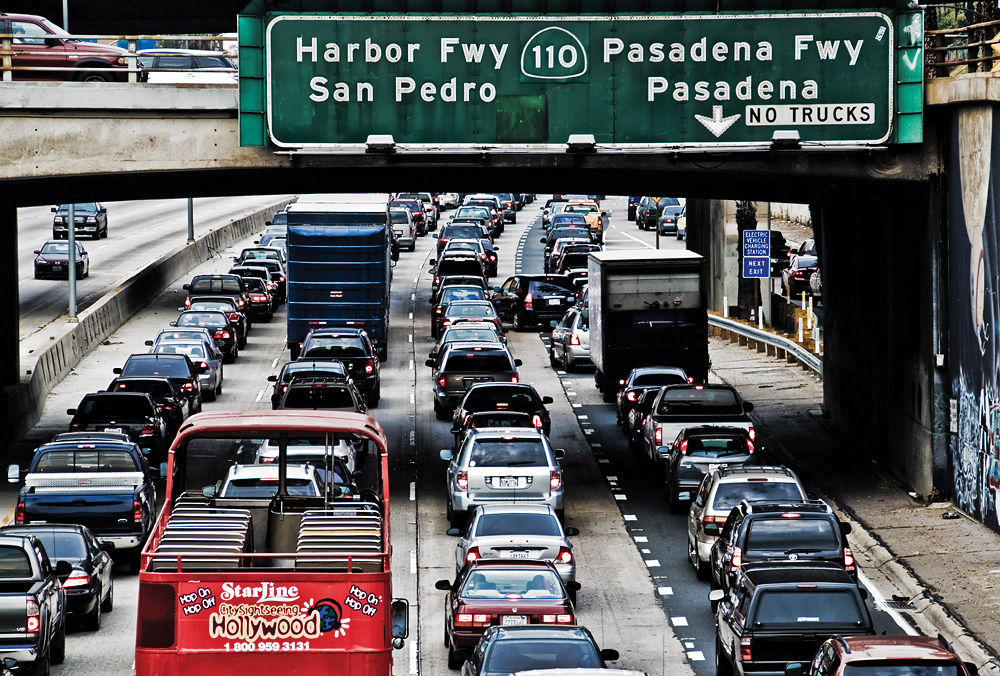
The 2011 Urban Mobility Report from the Texas Transportation Institute highlights the dangers of continued underinvestment in transportation infrastructure but also offers some hope in terms of possible solutions
While traffic problems have eased in the US along with the economy, the TTI’s annual study says that recession has only provided a temporary respite from the growing congestion problem. It suggests that too little progress is being made toward ensuring that the nation’s transportation system will be able to keep up with job growth when the economy does return to health.
The UMR illustrates congested conditions in 2010 on a number of levels, for example: the amount of delay endured by the average commuter was 34 hours, up from 14 hours in 1982; the cost of congestion is more than $100 billion, nearly $750 for every commuter in the US; ‘rush hour’ is six hours of not rushing anywhere; and congestion is becoming a bigger problem outside peak periods, with about 40 per cent of the delay occurring in the midday and overnight hours, creating an increasingly serious problem for businesses that rely on efficient production and deliveries.
The recent economic recession and continued slow recovery has only provided a temporary respite from the growing congestion problem.
When economic growth returns, the TTI predicts, the average commuter is expected to see an additional three hours of delay by 2015 and seven hours by 2020. By 2015, the cost of gridlock will rise from US$101 billion to $133 billion, more than $900 for every commuter, and the amount of wasted fuel will jump from 1.9 billion gallons to 2.5 billion gallons, enough to fill more than 275,000 gasoline tanker trucks.
Investment equates to prosperity
Research Engineer Tim Lomax, one of the UMR’s authors, observes that investment in roads and transite quates to better service and access to more jobs. “Traffic management and demand management should also be part of the mix,” he notes, adding that, “generally speaking, mobility investments in congested areas have a high return rate.”That connection was well understood in the 1960s, when the nation experienced its longest uninterrupted expansion in history, fuelled in part by federal investment in the interstate highway system. The interstate highway system grew rapidly from the late 1950s to the mid-1980s and the US economy grew along with it. Since then, however, growth in the interstate system has virtually stopped.
“The only way US companies have been able to keep their products competitive in the face of increasing traffic congestion and rising transportation costs is to squeeze every ounce of efficiency they can out of their supply chain,” says TTI Research Scientist David Ellis. “But there is a limit to efficiency and without additional transportation capacity, transportation costs will increase significantly. The result will be higher prices and lost jobs.”
For the second year running, the UMR combines traffic volume data from the states and traffic speed data from
The report underscores the traffic-economy connection that was outlined in another study published in June by the Texas 2030 Committee – It’s About Time: Investing in Transportation to Keep Texas Economically Competitive. Although the study focused on Texas, the implications are the same in every state. The typical commuter feels the impact of congestion in the form of stress and wasted time. But for manufacturers and shippers, this wasted time has a direct bottom line impact. Efficiency suffers, prices go up, and employment weakens.
“Congestion does more than choke our highways, it chokes our economy, making it harder to buy what we need and harder to keep or find a job,” Lomax says. “That’s a bad thing, especially when our economic recovery is so fragile.”
A nationwide issue
A key finding is that congestion is worse in areas of every size – as the UMR notes, it is no longer just a big city problem Regions of all sizes have problems implementing enough projects, programmes and policies to meeting the growing demands of population and jobs. Major projects, programmes and funding efforts take 10-15 years to develop, meanwhile.Freight bottleneck analysis of 250 significant US highway locations
The American Transportation Research Institute (ATRI) and the Federal Highway Administration (FHWA) have released the findings of their annual report on congestion at freight significant highway locations. The research assesses the level of truckoriented congestion at 250 locations on the national highway system to produce a congestion severity ranking for each location. This ongoing research, which is part of the Freight Performance Measures (FPM) initiative, is sponsored by FHWA’s Office of Freight Management and Operations and operated by ATRI.
The FPM congestion monitoring effort combines anonymous truck GPS location information with sophisticated software applications and analysis techniques to assess the levels at which truck-based freight was affected by traffic congestion in 2010.
The result is a clear documentation of system chokepoints, especially during peak travel times in urban locations.
“The impact of traffic congestion on truck travel is well known, but rarely in a fashion where we can pinpoint projects for resource allocation and reconstruction,” says Keith Bucklew, Manager of Multimodal Planning for the Indiana DOT. “The FPM programme continues to provide real value to public sector transportation managers.”
Kevin Knight, chairman and CEO of Knight Transportation: “Strengthening the efficiency of supply chains is becoming a critical component of US economic growth. Challenge number one is identifying the freight bottlenecks. Fortunately, ATRI’s report goes far in using real-world data to tell us where the impediments lie.”
Distinctions are made between delays to commuter and freight (truck) traffic. Correlations are also made between delays caused to the latter, to just-in-time production schedules and also, ultimately, to the increased price of commodities. Suggested solutions include new roads and rail lines, new lane capacity, truck-only lanes, increased handling capacity at warehouses and freight termini, new capacity to handle freight movement but to be an even larger need in coming years than passenger travel capacity. Regulatory changes, changes to operating practices or to the operating hours of freight or manufacturing facilities might also offer solutions. The UMR notes that addressing customs, immigration and security issues would also reduce congestion at border points-of-entry.
Multi-faceted answer
The most economical and effective congestion solutions involve traditional road building and transit use, combined with traffic management strategies such as signal coordination and rapid crash removal, and demand management strategies like telecommuting and flexible work hours. Land use and development patterns can play a positive role, as well. However through the UMR the TTI recommends a balanced and diversified approach, “one that focuses on more of everything”.Public transportation provides a significant amount of peak-period travel on the US’s most congested corridors and in urban areas. In the 439 urban areas which are the subject of the UMR, there were some 55 billion passenger miles of public travel in 2010. If in that period public transportation services had been discontinued and its users had transferred to private vehicles, those 439 urban areas would have suffered an additional 796 million hours of delay and consumed 300 million more gallons of fuel. The value of the additional travel delay would be $16.8 billion, a 17 per cent increase over current congestion costs in the same locations.
Stop-and-go roads carry only two-thirds of the capacity of smoothly flowing roads, the UMR notes, and so ways need to be found to improve efficiency. Examples of specific corridors and regions where solutions have been implemented can be found in the ‘Other Mobility Information and Resources’ section of the UMR’s website.
The importance of data
Some succour is provided in the UMR’s Concluding Thoughts where, it notes, significant benefits can be gained from aggressively attacking congestion problems, whatever their causes, in all types of geographic locations. In particular, performance measures and detailed data can help to guide investments, identify operating changes that should be made and provide reassurance that money to address issues is being spent well. That same rich data set can also guide transportation professionals to solutions that resonate with traveller experiences and frustrations. Although more efficiencies can and should be derived from existing infrastructure, and business and employees should look to modify their travel habits (including incorporating or increasing levels of electronic ‘travel’), there is no escaping the need for additional physical capacity.A copy of the full report, along with data tables and other supporting materials, can be found at













